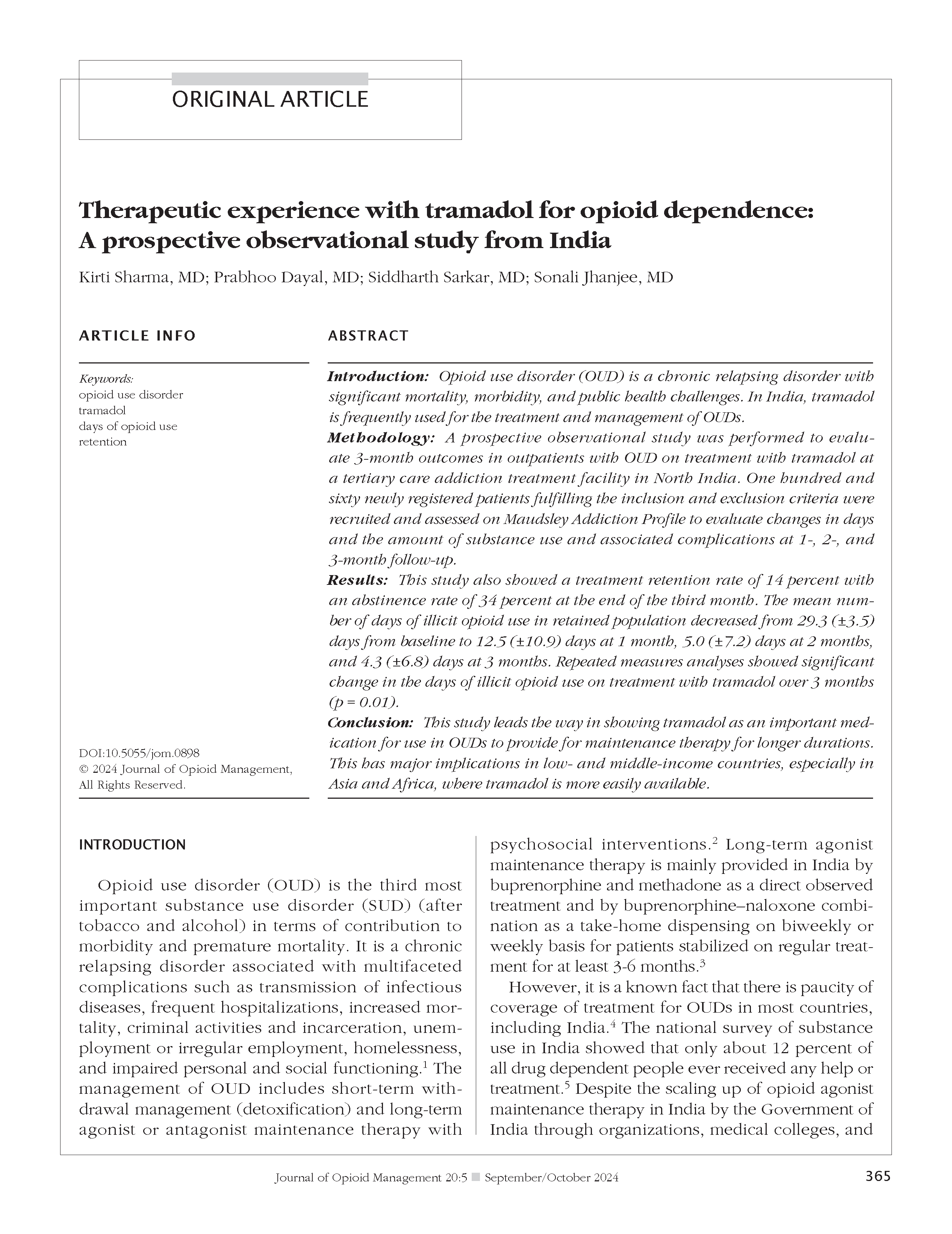Therapeutic experience with tramadol for opioid dependence: A prospective observational study from India
DOI:
https://doi.org/10.5055/jom.0898Keywords:
opioid use disorder, tramadol, days of opioid use, retentionAbstract
Introduction: Opioid use disorder (OUD) is a chronic relapsing disorder with significant mortality, morbidity, and public health challenges. In India, tramadol is frequently used for the treatment and management of OUDs.
Methodology: A prospective observational study was performed to evaluate 3-month outcomes in outpatients with OUD on treatment with tramadol at a tertiary care addiction treatment facility in North India. One hundred and sixty newly registered patients fulfilling the inclusion and exclusion criteria were recruited and assessed on Maudsley Addiction Profile to evaluate changes in days and the amount of substance use and associated complications at 1-, 2-, and 3-month follow-up.
Results: This study also showed a treatment retention rate of 14 percent with an abstinence rate of 34 percent at the end of the third month. The mean number of days of illicit opioid use in retained population decreased from 29.3 (±3.5) days from baseline to 12.5 (±10.9) days at 1 month, 5.0 (±7.2) days at 2 months, and 4.3 (±6.8) days at 3 months. Repeated measures analyses showed significant change in the days of illicit opioid use on treatment with tramadol over 3 months (p = 0.01).
Conclusion: This study leads the way in showing tramadol as an important medication for use in OUDs to provide for maintenance therapy for longer durations. This has major implications in low- and middle-income countries, especially in Asia and Africa, where tramadol is more easily available.
References
Strang J, Volkow ND, Degenhardt L, et al.: Opioid use disorder. Nat Rev Dis Primers. 2020; 6(1): 3. DOI: 10.1038/s41572-019-0137-5. DOI: https://doi.org/10.1038/s41572-019-0137-5
Kampman K, Jarvis M: American Society of Addiction Medicine (ASAM) national practice guideline for the use of medications in the treatment of addiction involving opioid use. J Addiction Med. 2015; 9(5): 358-367. DOI: 10.1097/ADM.0000000000000166. DOI: https://doi.org/10.1097/ADM.0000000000000166
Rao R: The journey of opioid substitution therapy in India: Achievements and challenges. Indian J Psychiatry. 2017; 59(1): 39. DOI: 10.4103/psychiatry.IndianJPsychiatry_37_17. DOI: https://doi.org/10.4103/psychiatry.IndianJPsychiatry_37_17
Degenhardt L, Grebely J, Stone J, et al.: Global patterns of opioid use and dependence: Harms to populations, interventions, and future action. Lancet. 2019; 394(10208): 1560-1579. DOI: 10.1016/S0140-6736(19)32229-9. DOI: https://doi.org/10.1016/S0140-6736(19)32229-9
Ambekar A, Agrawal A, Rao R, et al.: Magnitude of Substance Use in India. Delhi: Ministry of Social Justice and Empowerment, Government of India, 2019.
Balhara YPS, Parmar A, Sarkar S: Use of tramadol for management of opioid use disorders: Rationale and recommendations. J Neurosci Rural Practice. 2018; 9(3): 397-403. DOI: 10.4103/jnrp.jnrp_42_18. DOI: https://doi.org/10.4103/jnrp.jnrp_42_18
Sarkar S, Lal R, Varshney M, et al.: Can tramadol be used for maintenance treatment of opioid dependence? Substance Use Misuse. 2019; 54(3): 506-513. DOI: 10.1080/10826084.2018.1521427. DOI: https://doi.org/10.1080/10826084.2018.1521427
Marsden J, Gossop M, Stewart D, et al.: The Maudsley Addiction Profile (MAP): A brief instrument for assessing treatment outcome. Addiction (Abingdon, England). 1998; 93(12): 1857-1867. DOI: 10.1046/j.1360-0443.1998.9312185711.x. DOI: https://doi.org/10.1046/j.1360-0443.1998.9312185711.x
Singh VV, Sarkar S, Chadda RK, et al.: Reasons for leaving treatment among patients with opioid dependence: A 3-month prospective follow-up study. J Opioid Manag. 2022; 18(5): 455-466. DOI: 10.5055/jom.2022.0739. DOI: https://doi.org/10.5055/jom.2022.0739
Chan B, Gean E, Arkhipova-Jenkins I, et al.: Retention strategies for medications for opioid use disorder in adults: A rapid evidence review. J Addict Med. 2021; 15(1): 74-84. DOI: 10.1097/ADM.0000000000000739. DOI: https://doi.org/10.1097/ADM.0000000000000739
Sarkar S, Lal R, Varshney M, et al.: Tramadol for maintenance in opioid dependence: A retrospective chart review. J Opioid Manag. 2017; 13(5): 329-334. DOI: 10.5055/jom.2017.0401. DOI: https://doi.org/10.5055/jom.2017.0408
Dhawan A, Chopra A: Does buprenorphine maintenance improve the quality of life of opioid users? Indian J Med Res. 2013; 137(1): 130-135.
Dayal P, Balhara YPS: A naturalistic study of predictors of retention in treatment among emerging adults entering first buprenorphine maintenance treatment for opioid use disorders. J Substance Abuse Treat. 2017; 80: 1-5. DOI: 10.1016/j.jsat.2017.06.004. DOI: https://doi.org/10.1016/j.jsat.2017.06.004
Dayal P, Balhara YPS, Mishra AK: An open label naturalistic study of predictors of retention and compliance to naltrexone maintenance treatment among patients with opioid dependence. J Substance Use. 2016; 21(3): 309-316. DOI: 10.3109/14659891.2015.1021867. DOI: https://doi.org/10.3109/14659891.2015.1021867
Chand P, Murthy P: Short-term outcome of take-home prescriptions for opioid dependence: A clinic-based study. J Substance Use. 2013; 18(2): 108-118. DOI: 10.3109/14659891.2011.615882. DOI: https://doi.org/10.3109/14659891.2011.615882
Shouan A, Ghosh A, Singh SM, et al.: Predictors of retention in the treatment for opioid dependence: A prospective, observational study from India. Indian J Psychiatry. 2021; 63(4): 355-365. DOI: 10.4103/psychiatry.IndianJPsychiatry_448_20. DOI: https://doi.org/10.4103/psychiatry.IndianJPsychiatry_448_20
Chawla JM, Pal H, Lal R, et al.: Comparison of efficacy between buprenorphine and tramadol in the detoxification of opioid (heroin)-dependent subjects. J Opioid Manag. 2013; 9(1): 35-41. DOI: 10.5055/jom.2013.0145. DOI: https://doi.org/10.5055/jom.2013.0145
Tamaskar R, Parran TV, Heggi A, et al.: Tramadol versus buprenorphine for the treatment of opiate withdrawal: A retrospective cohort control study. J Addictive Dis. 2004; 22(4): 5-12. DOI: 10.1300/J069v22n04_02. DOI: https://doi.org/10.1300/J069v22n04_02
Threlkeld M, Threlkeld M, Parran TV, et al.: Tramadol versus buprenorphine for the management of acute heroin withdrawal: A retrospective matched cohort controlled study. Am J Addict. 2006; 15(2): 186-191. DOI: 10.1080/10550490500528712. DOI: https://doi.org/10.1080/10550490500528712
Majumder P, Sarkar S, Gupta R, et al.: Predictors of retention in treatment in a tertiary care de-addiction center. Indian J Psychiatry. 2016; 58(1): 27. DOI: 10.4103/0019-5545.174359. DOI: https://doi.org/10.4103/0019-5545.174359
Pandit PM, Bhatia G, Sarkar S: Treatment experience for opioid use disorder during COVID-19 in India: Learning from patients. J Substance Abuse Treat. 2020; 119: 108128. DOI: 10.1016/j.jsat.2020.108128. DOI: https://doi.org/10.1016/j.jsat.2020.108128
Oesterle TS, Thusius NJ, Rummans TA, et al.: Medication-assisted treatment for opioid-use disorder. Mayo Clin Proc. 2019; 94(10): 2072-2086. DOI: 10.1016/j.mayocp.2019.03.029. DOI: https://doi.org/10.1016/j.mayocp.2019.03.029

Published
How to Cite
Issue
Section
License
Copyright 2005-2025, Weston Medical Publishing, LLC and Journal of Opioid Management. All Rights Reserved.










